Synbiotic Food Market Insights 2025, Analysis and Forecast to 2030, by Manufacturers, Regions, Technology, Application
- Single User License (1 Users) $ 3,200
- Team License (2~5 Users) $ 4,200
- Corporate License (>5 Users) $ 5,200
Introduction to the Synbiotic Food Industry
Synbiotic foods combine live microorganisms (probiotics) and substrates selectively utilized by host microbes (prebiotics) to confer health benefits, as defined by the International Scientific Association for Probiotics and Prebiotics (ISAPP) in 2019. These products target gut health, immunity, and overall wellness, appealing to consumers seeking functional foods with scientifically backed benefits. Synbiotics are delivered in formats like yogurts, beverages, gummies, and supplements, leveraging advancements in microbial science and delivery systems. The industry is highly fragmented and competitive, driven by rising consumer awareness of microbiome health, increasing demand for personalized nutrition, and innovations in encapsulation and stability technologies. Unlike standalone probiotics or prebiotics, synbiotics offer synergistic effects, enhancing microbial survival and efficacy in the gut. Recent developments, such as gummy-based synbiotics and postbiotic integration, reflect the industry’s focus on convenience and novel formats. Regulatory frameworks vary globally, with stringent standards in Europe and evolving guidelines in Asia, influencing product development and marketing strategies.
Market Size and Growth Forecast
The global synbiotic food market is projected to reach USD 5.5 billion to USD 6.5 billion by 2025, with an estimated compound annual growth rate (CAGR) of 10% to 12% through 2030, driven by growing health consciousness, expanding retail channels, and innovations in product formulations.
Regional Analysis
North America is expected to exhibit a growth rate of 9% to 11%. The U.S. leads due to high consumer awareness of gut health, robust demand for functional foods, and widespread availability through pharmacies and online platforms. Canada’s market is growing steadily, supported by wellness trends and regulatory clarity on health claims.
Europe anticipates a growth rate of 10% to 12%. Germany, France, and the UK dominate, driven by stringent regulations ensuring product efficacy and consumer trust in functional foods. Scandinavia emphasizes clean-label and organic synbiotics, aligning with sustainability trends.
Asia Pacific projects a growth rate of 12% to 14%. Japan’s established probiotic culture, led by brands like Yakult, drives synbiotic adoption, while China’s rising middle class and health-focused millennials fuel demand. India’s market is emerging, with growth in urban areas due to increasing dietary supplement use.
South America expects a growth rate of 7% to 9%. Brazil’s expanding health food sector supports synbiotic growth, though economic volatility limits scalability.
Middle East and Africa anticipate a growth rate of 6% to 8%. The UAE and South Africa show potential due to growing retail infrastructure, but limited awareness hinders broader adoption.
Application Analysis
Pharmacy: Projected at 10% to 12%, pharmacies dominate due to consumer trust in health-focused retail and professional endorsements. Trends include targeted synbiotics for specific conditions like IBS, with brands like Ritual emphasizing transparency.
Supermarket: Expected at 9% to 11%, supermarkets benefit from mass-market accessibility and diverse product formats like yogurts and beverages. Danone’s fortified dairy products lead, with private-label synbiotics gaining traction.
Convenience Store: Anticipated at 7% to 9%, convenience stores cater to on-the-go consumers, with portable formats like synbiotic drinks and gummies. Yakult’s single-serve beverages exemplify this trend.
Online Sales: Projected at 12% to 14%, online channels are the fastest-growing, driven by e-commerce platforms and direct-to-consumer models. Seed’s subscription-based synbiotics leverage digital marketing and consumer education.
Key Market Players
Danone: A French leader, Danone produces synbiotic yogurts and beverages.
Yakult Honsha: A Japanese firm, Yakult develops probiotic drinks for Asia.
Priegola: A European company, Priegola focuses on plant-based synbiotics.
GT’s Living Foods: A U.S. firm, GT’s scales kombucha with synbiotic properties.
Honest Tea: A U.S. company, Honest Tea offers synbiotic-infused beverages.
Sabinsa: A U.S. firm, Sabinsa supplies synbiotic supplements for pharmacies.
Probiotical: An Italian company, Probiotical develops targeted synbiotic strains.
United Naturals: A U.S. firm, United Naturals focuses on gut health supplements.
Synbiotic Health: A U.S. company, Synbiotic Health advances personalized synbiotics.
Seed: A U.S. firm, Seed offers subscription-based synbiotic capsules.
Ritual: A U.S. company, Ritual develops e-commerce synbiotic supplements.
Porter’s Five Forces Analysis
●Threat of New Entrants: Moderate. High R&D costs and regulatory hurdles deter entry, but declining production costs and consumer demand lower barriers. Established players like Danone leverage brand loyalty and scale, though startups like Synbiotic Health capitalize on niche innovation.
●Threat of Substitutes: High. Probiotics, prebiotics, and functional foods compete directly, with consumers often unaware of synbiotics’ synergistic benefits. Yakult faces competition from non-synbiotic health drinks, though scientific validation strengthens synbiotics’ position.
●Bargaining Power of Buyers: High. Consumers and retailers have significant leverage due to the fragmented market and diverse product options. Price sensitivity in supermarkets pressures Priegola, but premium branding in pharmacies stabilizes demand.
●Bargaining Power of Suppliers: Moderate. Suppliers of microbial strains and prebiotic fibers influence costs, but diversified sourcing by Sabinsa mitigates risks. Specialized ingredients grant some supplier power, particularly in Europe’s regulated markets.
●Competitive Rivalry: High. Danone, Yakult, and Probiotical compete on innovation, branding, and distribution. Rapid consumer trends toward personalized nutrition and novel formats like gummies drive R&D, intensifying rivalry.
Market Opportunities and Challenges
Opportunities
●Rising Health Awareness: Growing consumer focus on gut health and immunity boosts demand for Danone’s synbiotic yogurts.
●E-Commerce Growth: Online platforms enable Seed’s subscription models to reach global consumers efficiently.
●Personalized Nutrition: Advances in microbiome research support Ritual’s targeted synbiotic formulations.
●Novel Formats: Gummies and beverages, like TopGum’s Gummiotics, appeal to younger demographics.
●Emerging Markets: India’s urban health trends offer export potential for Sabinsa’s supplements.
●Sustainability Trends: Eco-friendly packaging and organic synbiotics align with GT’s Living Foods’ ethos.
●Regulatory Support: Europe’s clear health claim guidelines bolster Probiotical’s market credibility.
Challenges
●Regulatory Variability: Diverse global standards increase compliance costs for Yakult’s international expansion.
●Consumer Awareness: Limited understanding of synbiotics’ benefits slows adoption in Africa, impacting United Naturals.
●High R&D Costs: Developing stable, effective formulations pressures Synbiotic Health’s profitability.
●Competition from Substitutes: Probiotics and functional foods challenge Danone’s market share.
●Supply Chain Volatility: Microbial strain shortages disrupt Priegola’s production.
●Counterfeit Products: Online sales expose Ritual to risks of low-quality imitations.
●Brand Differentiation: Intense competition requires GT’s Living Foods to invest heavily in marketing.
Chapter 1 Executive Summary
Chapter 2 Abbreviation and Acronyms
Chapter 3 Preface
3.1 Research Scope
3.2 Research Sources
3.2.1 Data Sources
3.2.2 Assumptions
3.3 Research Method
Chapter 4 Market Landscape
4.1 Market Overview
4.2 Classification/Types
4.3 Application/End Users
Chapter 5 Market Trend Analysis
5.1 Introduction
5.2 Drivers
5.3 Restraints
5.4 Opportunities
5.5 Threats
Chapter 6 Industry Chain Analysis
6.1 Upstream/Suppliers Analysis
6.2 Synbiotic Food Analysis
6.2.1 Technology Analysis
6.2.2 Cost Analysis
6.2.3 Market Channel Analysis
6.3 Downstream Buyers/End Users
Chapter 7 Latest Market Dynamics
7.1 Latest News
7.2 Merger and Acquisition
7.3 Planned/Future Project
7.4 Policy Dynamics
Chapter 8 Historical and Forecast Synbiotic Food Market in North America (2020-2030)
8.1 Synbiotic Food Market Size
8.2 Synbiotic Food Market by End Use
8.3 Competition by Players/Suppliers
8.4 Synbiotic Food Market Size by Type
8.5 Key Countries Analysis
8.5.1 United States
8.5.2 Canada
8.5.3 Mexico
Chapter 9 Historical and Forecast Synbiotic Food Market in South America (2020-2030)
9.1 Synbiotic Food Market Size
9.2 Synbiotic Food Market by End Use
9.3 Competition by Players/Suppliers
9.4 Synbiotic Food Market Size by Type
9.5 Key Countries Analysis
9.5.1 Brazil
9.5.2 Argentina
9.5.3 Chile
9.5.4 Peru
Chapter 10 Historical and Forecast Synbiotic Food Market in Asia & Pacific (2020-2030)
10.1 Synbiotic Food Market Size
10.2 Synbiotic Food Market by End Use
10.3 Competition by Players/Suppliers
10.4 Synbiotic Food Market Size by Type
10.5 Key Countries Analysis
10.5.1 China
10.5.2 India
10.5.3 Japan
10.5.4 South Korea
10.5.5 Southest Asia
10.5.6 Australia
Chapter 11 Historical and Forecast Synbiotic Food Market in Europe (2020-2030)
11.1 Synbiotic Food Market Size
11.2 Synbiotic Food Market by End Use
11.3 Competition by Players/Suppliers
11.4 Synbiotic Food Market Size by Type
11.5 Key Countries Analysis
11.5.1 Germany
11.5.2 France
11.5.3 United Kingdom
11.5.4 Italy
11.5.5 Spain
11.5.6 Belgium
11.5.7 Netherlands
11.5.8 Austria
11.5.9 Poland
11.5.10 Russia
Chapter 12 Historical and Forecast Synbiotic Food Market in MEA (2020-2030)
12.1 Synbiotic Food Market Size
12.2 Synbiotic Food Market by End Use
12.3 Competition by Players/Suppliers
12.4 Synbiotic Food Market Size by Type
12.5 Key Countries Analysis
12.5.1 Egypt
12.5.2 Israel
12.5.3 South Africa
12.5.4 Gulf Cooperation Council Countries
12.5.5 Turkey
Chapter 13 Summary For Global Synbiotic Food Market (2020-2025)
13.1 Synbiotic Food Market Size
13.2 Synbiotic Food Market by End Use
13.3 Competition by Players/Suppliers
13.4 Synbiotic Food Market Size by Type
Chapter 14 Global Synbiotic Food Market Forecast (2025-2030)
14.1 Synbiotic Food Market Size Forecast
14.2 Synbiotic Food Application Forecast
14.3 Competition by Players/Suppliers
14.4 Synbiotic Food Type Forecast
Chapter 15 Analysis of Global Key Vendors
15.1 Danone
15.1.1 Company Profile
15.1.2 Main Business and Synbiotic Food Information
15.1.3 SWOT Analysis of Danone
15.1.4 Danone Synbiotic Food Sales, Revenue, Price and Gross Margin (2020-2025)
15.2 Yakult Honsha
15.2.1 Company Profile
15.2.2 Main Business and Synbiotic Food Information
15.2.3 SWOT Analysis of Yakult Honsha
15.2.4 Yakult Honsha Synbiotic Food Sales, Revenue, Price and Gross Margin (2020-2025)
15.3 Priegola
15.3.1 Company Profile
15.3.2 Main Business and Synbiotic Food Information
15.3.3 SWOT Analysis of Priegola
15.3.4 Priegola Synbiotic Food Sales, Revenue, Price and Gross Margin (2020-2025)
15.4 GT's Living Foods
15.4.1 Company Profile
15.4.2 Main Business and Synbiotic Food Information
15.4.3 SWOT Analysis of GT's Living Foods
15.4.4 GT's Living Foods Synbiotic Food Sales, Revenue, Price and Gross Margin (2020-2025)
15.5 Honest Tea
15.5.1 Company Profile
15.5.2 Main Business and Synbiotic Food Information
15.5.3 SWOT Analysis of Honest Tea
15.5.4 Honest Tea Synbiotic Food Sales, Revenue, Price and Gross Margin (2020-2025)
15.6 Sabinsa
15.6.1 Company Profile
15.6.2 Main Business and Synbiotic Food Information
15.6.3 SWOT Analysis of Sabinsa
15.6.4 Sabinsa Synbiotic Food Sales, Revenue, Price and Gross Margin (2020-2025)
15.7 Probiotical
15.7.1 Company Profile
15.7.2 Main Business and Synbiotic Food Information
15.7.3 SWOT Analysis of Probiotical
15.7.4 Probiotical Synbiotic Food Sales, Revenue, Price and Gross Margin (2020-2025)
Please ask for sample pages for full companies list
Table Research Scope Of Synbiotic Food Report
Table Data Sources Of Synbiotic Food Report
Table Major Assumptions Of Synbiotic Food Report
Table Synbiotic Food Classification
Table Synbiotic Food Applications
Table Drivers Of Synbiotic Food Market
Table Restraints Of Synbiotic Food Market
Table Opportunities Of Synbiotic Food Market
Table Threats Of Synbiotic Food Market
Table Raw Materials Suppliers
Table Different Production Methods Of Synbiotic Food
Table Cost Structure Analysis Of Synbiotic Food
Table Key End Users
Table Latest News Of Synbiotic Food Market
Table Merger And Acquisition
Table Planned/Future Project Of Synbiotic Food Market
Table Policy Of Synbiotic Food Market
Table 2020-2030 North America Synbiotic Food Market Size
Table 2020-2030 North America Synbiotic Food Market Size By Application
Table 2020-2025 North America Synbiotic Food Key Players Revenue
Table 2020-2025 North America Synbiotic Food Key Players Market Share
Table 2020-2030 North America Synbiotic Food Market Size By Type
Table 2020-2030 United States Synbiotic Food Market Size
Table 2020-2030 Canada Synbiotic Food Market Size
Table 2020-2030 Mexico Synbiotic Food Market Size
Table 2020-2030 South America Synbiotic Food Market Size
Table 2020-2030 South America Synbiotic Food Market Size By Application
Table 2020-2025 South America Synbiotic Food Key Players Revenue
Table 2020-2025 South America Synbiotic Food Key Players Market Share
Table 2020-2030 South America Synbiotic Food Market Size By Type
Table 2020-2030 Brazil Synbiotic Food Market Size
Table 2020-2030 Argentina Synbiotic Food Market Size
Table 2020-2030 Chile Synbiotic Food Market Size
Table 2020-2030 Peru Synbiotic Food Market Size
Table 2020-2030 Asia & Pacific Synbiotic Food Market Size
Table 2020-2030 Asia & Pacific Synbiotic Food Market Size By Application
Table 2020-2025 Asia & Pacific Synbiotic Food Key Players Revenue
Table 2020-2025 Asia & Pacific Synbiotic Food Key Players Market Share
Table 2020-2030 Asia & Pacific Synbiotic Food Market Size By Type
Table 2020-2030 China Synbiotic Food Market Size
Table 2020-2030 India Synbiotic Food Market Size
Table 2020-2030 Japan Synbiotic Food Market Size
Table 2020-2030 South Korea Synbiotic Food Market Size
Table 2020-2030 Southeast Asia Synbiotic Food Market Size
Table 2020-2030 Australia Synbiotic Food Market Size
Table 2020-2030 Europe Synbiotic Food Market Size
Table 2020-2030 Europe Synbiotic Food Market Size By Application
Table 2020-2025 Europe Synbiotic Food Key Players Revenue
Table 2020-2025 Europe Synbiotic Food Key Players Market Share
Table 2020-2030 Europe Synbiotic Food Market Size By Type
Table 2020-2030 Germany Synbiotic Food Market Size
Table 2020-2030 France Synbiotic Food Market Size
Table 2020-2030 United Kingdom Synbiotic Food Market Size
Table 2020-2030 Italy Synbiotic Food Market Size
Table 2020-2030 Spain Synbiotic Food Market Size
Table 2020-2030 Belgium Synbiotic Food Market Size
Table 2020-2030 Netherlands Synbiotic Food Market Size
Table 2020-2030 Austria Synbiotic Food Market Size
Table 2020-2030 Poland Synbiotic Food Market Size
Table 2020-2030 Russia Synbiotic Food Market Size
Table 2020-2030 Mea Synbiotic Food Market Size
Table 2020-2030 Mea Synbiotic Food Market Size By Application
Table 2020-2025 Mea Synbiotic Food Key Players Revenue
Table 2020-2025 Mea Synbiotic Food Key Players Market Share
Table 2020-2030 Mea Synbiotic Food Market Size By Type
Table 2020-2030 Egypt Synbiotic Food Market Size
Table 2020-2030 Israel Synbiotic Food Market Size
Table 2020-2030 South Africa Synbiotic Food Market Size
Table 2020-2030 Gulf Cooperation Council Countries Synbiotic Food Market Size
Table 2020-2030 Turkey Synbiotic Food Market Size
Table 2020-2025 Global Synbiotic Food Market Size By Region
Table 2020-2025 Global Synbiotic Food Market Size Share By Region
Table 2020-2025 Global Synbiotic Food Market Size By Application
Table 2020-2025 Global Synbiotic Food Market Share By Application
Table 2020-2025 Global Synbiotic Food Key Vendors Revenue
Table 2020-2025 Global Synbiotic Food Key Vendors Market Share
Table 2020-2025 Global Synbiotic Food Market Size By Type
Table 2020-2025 Global Synbiotic Food Market Share By Type
Table 2025-2030 Global Synbiotic Food Market Size By Region
Table 2025-2030 Global Synbiotic Food Market Size Share By Region
Table 2025-2030 Global Synbiotic Food Market Size By Application
Table 2025-2030 Global Synbiotic Food Market Share By Application
Table 2025-2030 Global Synbiotic Food Key Vendors Revenue
Table 2025-2030 Global Synbiotic Food Key Vendors Market Share
Table 2025-2030 Global Synbiotic Food Market Size By Type
Table 2025-2030 Synbiotic Food Global Market Share By Type
Figure Market Size Estimated Method
Figure Major Forecasting Factors
Figure Synbiotic Food Picture
Figure 2020-2030 North America Synbiotic Food Market Size And Cagr
Figure 2020-2030 South America Synbiotic Food Market Size And Cagr
Figure 2020-2030 Asia & Pacific Synbiotic Food Market Size And Cagr
Figure 2020-2030 Europe Synbiotic Food Market Size And Cagr
Figure 2020-2030 Mea Synbiotic Food Market Size And Cagr
Figure 2020-2025 Global Synbiotic Food Market Size And Growth Rate
Figure 2025-2030 Global Synbiotic Food Market Size And Growth Rate
Research Methodology
- Market Estimated Methodology:
Bottom-up & top-down approach, supply & demand approach are the most important method which is used by HDIN Research to estimate the market size.
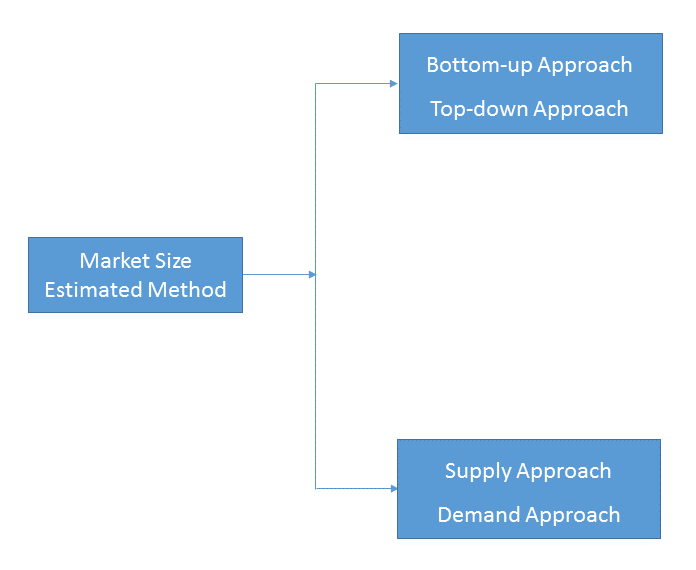
1)Top-down & Bottom-up Approach
Top-down approach uses a general market size figure and determines the percentage that the objective market represents.
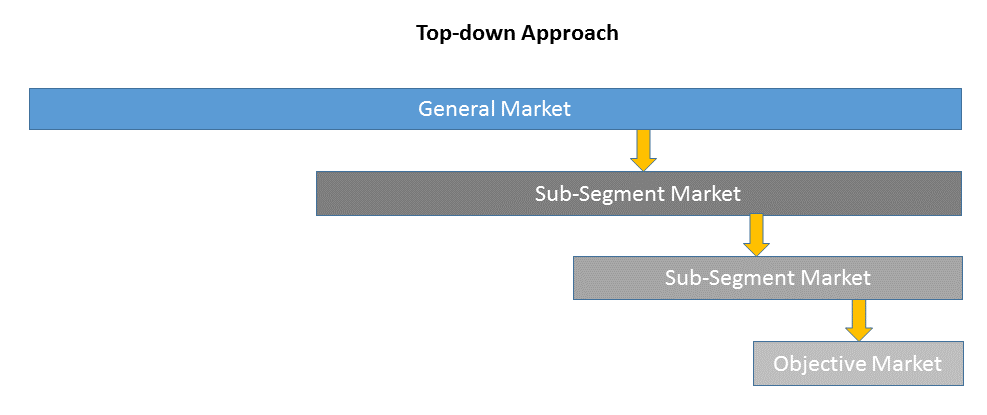
Bottom-up approach size the objective market by collecting the sub-segment information.

2)Supply & Demand Approach
Supply approach is based on assessments of the size of each competitor supplying the objective market.
Demand approach combine end-user data within a market to estimate the objective market size. It is sometimes referred to as bottom-up approach.
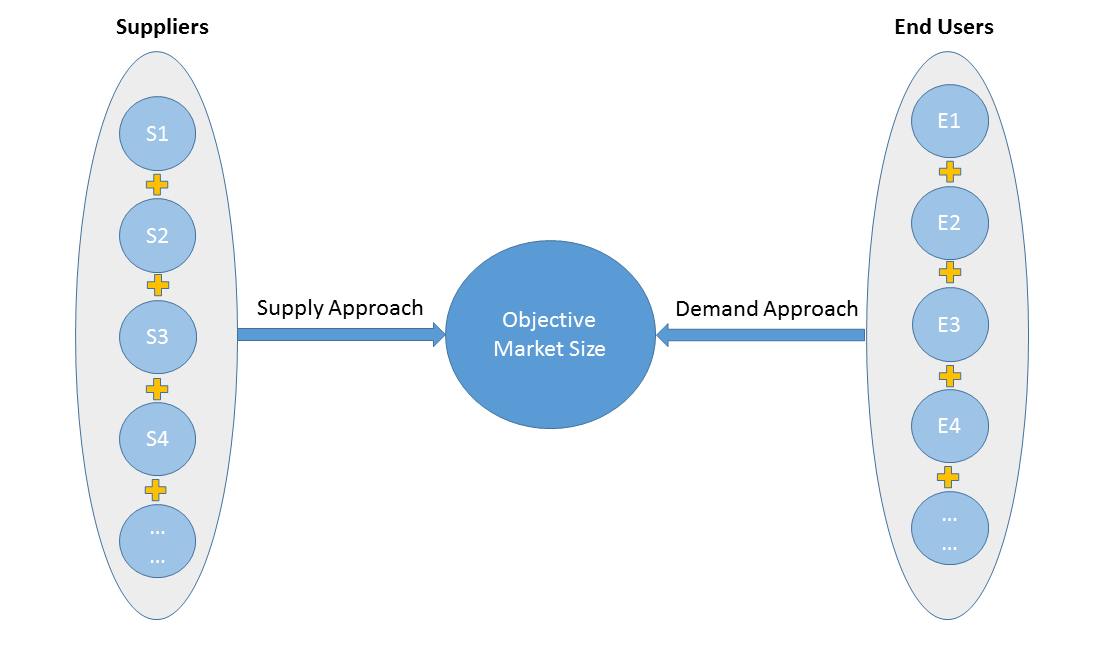
- Forecasting Methodology
- Numerous factors impacting the market trend are considered for forecast model:
- New technology and application in the future;
- New project planned/under contraction;
- Global and regional underlying economic growth;
- Threatens of substitute products;
- Industry expert opinion;
- Policy and Society implication.
- Analysis Tools
1)PEST Analysis
PEST Analysis is a simple and widely used tool that helps our client analyze the Political, Economic, Socio-Cultural, and Technological changes in their business environment.
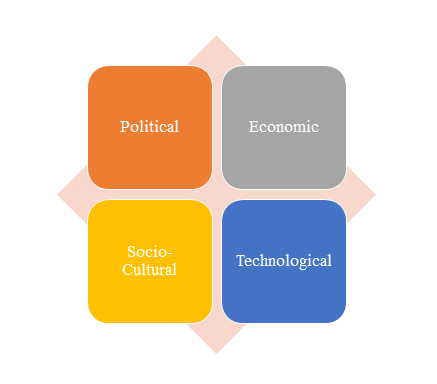
- Benefits of a PEST analysis:
- It helps you to spot business opportunities, and it gives you advanced warning of significant threats.
- It reveals the direction of change within your business environment. This helps you shape what you’re doing, so that you work with change, rather than against it.
- It helps you avoid starting projects that are likely to fail, for reasons beyond your control.
- It can help you break free of unconscious assumptions when you enter a new country, region, or market; because it helps you develop an objective view of this new environment.
2)Porter’s Five Force Model Analysis
The Porter’s Five Force Model is a tool that can be used to analyze the opportunities and overall competitive advantage. The five forces that can assist in determining the competitive intensity and potential attractiveness within a specific area.
- Threat of New Entrants: Profitable industries that yield high returns will attract new firms.
- Threat of Substitutes: A substitute product uses a different technology to try to solve the same economic need.
- Bargaining Power of Customers: the ability of customers to put the firm under pressure, which also affects the customer's sensitivity to price changes.
- Bargaining Power of Suppliers: Suppliers of raw materials, components, labor, and services (such as expertise) to the firm can be a source of power over the firm when there are few substitutes.
- Competitive Rivalry: For most industries the intensity of competitive rivalry is the major determinant of the competitiveness of the industry.
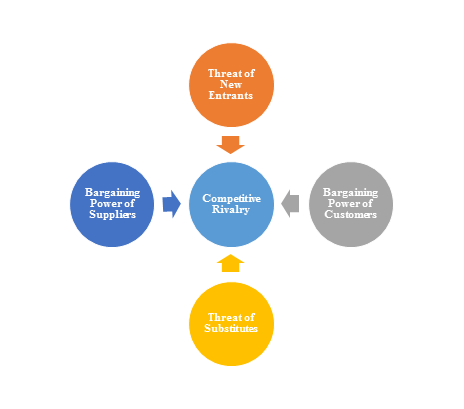
3)Value Chain Analysis
Value chain analysis is a tool to identify activities, within and around the firm and relating these activities to an assessment of competitive strength. Value chain can be analyzed by primary activities and supportive activities. Primary activities include: inbound logistics, operations, outbound logistics, marketing & sales, service. Support activities include: technology development, human resource management, management, finance, legal, planning.
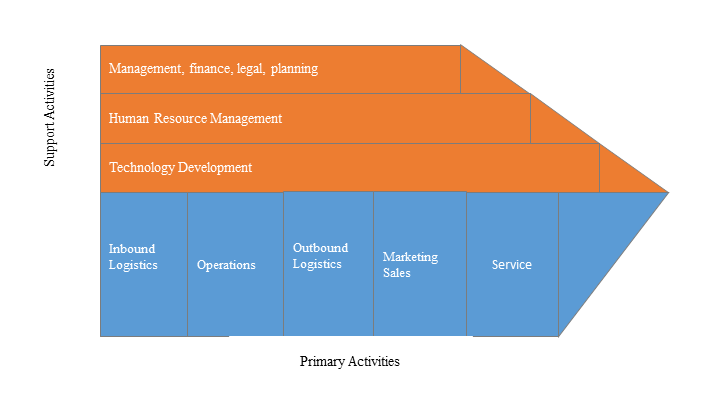
4)SWOT Analysis
SWOT analysis is a tool used to evaluate a company's competitive position by identifying its strengths, weaknesses, opportunities and threats. The strengths and weakness is the inner factor; the opportunities and threats are the external factor. By analyzing the inner and external factors, the analysis can provide the detail information of the position of a player and the characteristics of the industry.
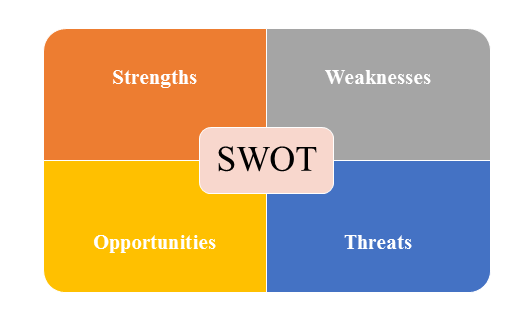
- Strengths describe what the player excels at and separates it from the competition
- Weaknesses stop the player from performing at its optimum level.
- Opportunities refer to favorable external factors that the player can use to give it a competitive advantage.
- Threats refer to factors that have the potential to harm the player.
- Data Sources
| Primary Sources | Secondary Sources |
|---|---|
| Face to face/Phone Interviews with market participants, such as: Manufactures; Distributors; End-users; Experts. Online Survey |
Government/International Organization Data: Annual Report/Presentation/Fact Book Internet Source Information Industry Association Data Free/Purchased Database Market Research Report Book/Journal/News |